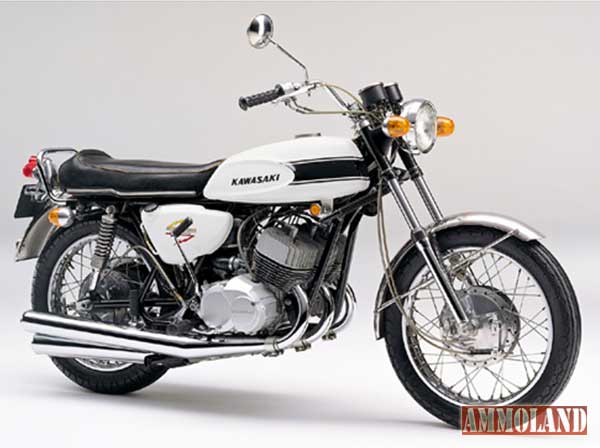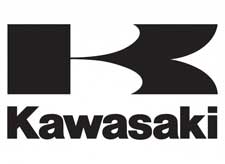With an audacious three-cylinder engine and the dragstrip wizardry of Tony Nicosia, the 1969 Kawasaki H1 immediately became a performance icon.


IRVINE, Calif. – -(Ammoland.com)- When it comes to performance, few motorcycles in the last 50 years created the impact that Kawasaki’s 500 Mach III two-stroke triple did in 1969.
Coming right on the heels of the 350cc A7 Avenger, the Mach III (also known as the “H1” model) vaulted performance to new heights, at an equally amazing price of just $999. Sharpening its point, the H1 quickly set acceleration records, with Tony Nicosia making a ¼-mile run of 12.96 seconds at 100.7 miles per hour aboard the raging triple.
A highly accomplished drag racer, Nicosia was also a Kawasaki service technician and development rider for the H1, which had been tested extensively in the Southwest – including near Nevada’s secret military base Area 51.
Such rider talent is essential in wringing the most out of a bike on the dragstrip, but the underlying machine has to be capable. The Mach III was. Its 499cc piston-port triple was like three highly tweaked two-strokes ganged together, with three Mikuni carburetors, three separate inductive pickups for its hot CDI ignition, and three individually tuned exhausts producing a kind of high-intensity acceleration no other production bike could match.
As a result, the language of the H1 – actually a rapturous howl! – immediately became spoken in high-performance motorcycle circles.
And the H1 just as quickly became known to car guys, as many a Corvette, GTO and Mustang owner learned after encountering a Kawasaki Mach III.
The H1 model run lasted eight years, from the first drum-brake 1969-71 H1 and H1A versions through the disc-brake KH500 swansong in 1976. Finally, the triple became a casualty of emissions laws and was replaced by the four-stroke KZ650 model. But what a run it was. Among its high points were those blistering early runs that Nicosia made at a special press demonstration at Lions Drag Strip in Southern California. Here personnel uncrated a brand-new H1 and put Nicosia aboard, where he soon scorched to the world’s first sub 13-second 1/4-mile run on a production bike. Although brand-new, the H1’s legend was already secure.
In time, the audacious H1 became known by a number of nicknames, some of which are not repeatable here. However, all recognized the incredible performance of its seething three-cylinder two-stroke engine, which helped make motorcycling an incredibly exciting sport in 1969 and beyond. Long live the Kawasaki Mach III.

ABOUT KAWASAKI
Kawasaki Heavy Industries, Ltd. (KHI) started full-scale production of motorcycles over a half century ago. The first Kawasaki motorcycle engine was designed based on technical know-how garnered from the development and production of aircraft engines, and Kawasaki’s entry into the motorcycle industry was driven by the company’s constant effort to develop new technologies. Numerous new Kawasaki models introduced over the years have helped shape the market, and in the process have created enduring legends based on their unique engineering, power, design and riding pleasure. In the future, Kawasaki’s commitment to maintaining and furthering these strengths will surely give birth to new legends.
Kawasaki Motors Corp., U.S.A. (KMC) markets and distributes Kawasaki motorcycles, ATVs, side x sides, and Jet Ski® watercraft through a network of approximately 1,100 independent retailers, with close to an additional 7,700 retailers specializing in general purpose engines. KMC and its affiliates employ nearly 3,100 people in the United States, with approximately 300 of them located at KMC’s Irvine, California headquarters.
Kawasaki’s tagline, “Let the good times roll.®”, is recognized worldwide. The Kawasaki brand is synonymous with powerful, stylish and category-leading vehicles. Information about Kawasaki’s complete line of powersports products and Kawasaki affiliates can be found on the Internet at www.kawasaki.com.

Hi.
I am looking for frames kawasaki 750 H2 years 1972 and 1973.
Patrick
I owned a 70 H1. It was one pure adrenalin machine. Popping wheelies at 70 mph was way too easy. When the hot new Suzuki 4 cyl DOHC came out, a rider decided he would impress me. After a brief contest he wasn’t so impressed with his pricey new toy. He probably still remembers the taste and smell of the two stroke oil cloud I left him in. Cornering left a lot to be desired, as did the very short life span of the rear tire, spokes and chain/sprockets set. ~3000 miles. After I bought it, it just wouldn’t stop… Read more »
Took my ’69 out in 8° weather on icy streets in Omaha one winter. Hilarity ensued. Did remain upright, though.
I remember another time hitting 5500 in 3rd, front wheel coming up. S L O W L Y backed off the throttle. Never did that again—wheel at 90 mph. NOPE!
Would I own another one?? You betcha!! I can still hear that echo in my helmet when it comes on the pipe!
Bill Turlock
In a straight line, or on a curved (road course) track, with an experienced rider, they were, indeed, wicked fast. However, on the street, with a rider who didn’t understand the cornering characteristics, the understeer would be their undoing. Why the understeer? These bikes were set up to be very stable at speed in a straight line, specifically so the average rider could use the power. Steering input needed to be higher than usual, and gradually applied, or the bike simply plowed ahead; inexperienced riders would then apply more input, and the bike responded by going into wild, erratic movements,… Read more »
I just dropped around $800 for an expert crank rebuild for my H1b project, and know it’s worth every penny..
I still have several 1972 H1-B 500s with the front disc brake, but a points ignition system. I ran in the low 12 second range at Onondaga Dragway in Michigan back in the mid seventies. I also ran it at Irwindale Raceway and Orange County International Raceway in the late seventies. It was a crowd pleaser! It was fun to ride, but very squirrely and could go into a tank slapping speed wobble when you really let ‘er rip.
Can you believe that with all Tony Nicosia did back then, that the AMA has passed him over so far, for the Hall-of-Fame?
A friend claimed he could feel the frame flex through the “twisties”. He called his the “flexible flier” like the snow sleds we had as kids.
I remember these bikes so well! Novices were prone to wheelie and bring the bike over on top of themselves with that ferocious acceleration and bike’s light weight. Handling through the turns and twisties wasn’t that great either because of the light-weight frame’s lack of rigidity. But anyone who witnessed one of these bike’s acceleration, even from a rolling start or cruising , will remember the sound and the sight of that front wheel coming off the ground and being carried in the air for an insane distance!
Problem was that full power came on suddenly. We use to bet on how long some customers would last before the bike came back to shop. Loved the new guys who insisted they did not need introduction class on back lot before the street. Shortest return was 30 minutes. Cranked on coming off light and brought it over just as you said.
One of the street stories of the time was that Kawasaki had to switch seat cover material from their typical smooth, leather-like plastic material to a suede type material because riders were sliding off the back during acceleration.
My beautiful, electric blue ’72 H2 750 Triple solved the problem with a rise in the seat back, but she could sure fly!
The two strokes of that period were fantastic. Even the little Yamaha RD 350 was a scary-quick little bike. Too bad Nixon killed off the bikes by enacting the EPA.
Adjusted for inflation todays price for the 1969 H-1 would be $6500.
You would have a hard time finding a new motorcycle at that price.
A new Honda CB500F goes for $8500, a Kawasaki ZX-6R $11,700, a Suzuki GSX-R600 $11,200 and a Harley-Davidson Street 500 $6850.
Hmmm, looks like Harley has found a sweet spot price.
I had the 750 H2a in the late 70’s.
It was truly incredible.
Scary quick.